Inside Marco Siffredi's Bizarre Daredevil Mt. Everest Death
People have been braving Everest for over 100 years, though the first time humans reached the summit was in 1953. The world's highest mountain is the ultimate challenge for climbers and daredevils, so it's no surprise that many who are looking for the thrill of a lifetime end up there, reports National Geographic.
As of November 2022, more than 300 people have died on Everest – that's a death rate of around 5%, or one in 20, according to Climber News. Most people who die on Everest lose their lives in the Death Zone, the area above 26,200 feet where the air is so thin, altitude sickness, frostbite, and exposure kill a significant number of people. Avalanches and falling (in that order) are the two main causes of death on Everest, especially because climbers tend to be tied up together with ropes when climbing or descending. An avalanche or tripping and falling can result in the death of several climbers at once (via Alpine Insider).
Despite all the risks of climbing the mighty mountain, most of Everest's deaths don't occur at the top, but during the descent. According to Scientific American, over 56% of those who have died on Everest were on their way back from the summit, compared to 15% dying on their way up. The one thing all these deaths have in common is that the victims were climbers — except for one: French snowboarder Marco Siffredi died while attempting something completely different (per Men's Journal).
Trying the impossible
Siffredi was only 23 years old when he died on Everest and had only been a daredevil snowboarder for four years. During those four years, however, he had achieved quite a bit of magic on the slopes. He'd snowboarded down one of Peru's tallest mountain (Mount Tocllaraju), rode the Nant Blanc (part of the Mont Blanc massif), and climbed and then snowboarded down two different mountains in Nepal (via Adventure Journal). But Siffredi, who was born in Chamonix, France (the birthplace of Alpinism) had been on the slopes since he was a child. At the age of 17, he and a friend were the first two people to snowboard down the Chardonnet, a difficult mountain to climb with a 55 degrees incline (per Snowboarder). From then on, the goal became to go higher and go faster.
In May 2001, Siffredi finally made his way to Everest, with the goal of first summitting and then snowboarding down the mountain, a feat that had never been attempted. He reached the summit successfully and then intended to snowboard on the Hornbein Couloir side of the mountain — the steepest way down — but there was not enough snow on the ground to make it possible, according to Adventure Journal.
He still managed to snowboard down the Norton Couloir on the North Face of the mountain, a route that was somewhat easier (a relative term when you're on Everest), and became the first person to snowboard down the mighty mountain (per Planet Mountain). The descent took 2 hours and 20 minutes, according to Planet Mountain.
A mysterious disappearance
But Siffredi wasn't satisfied and he returned in 2002 to attempt the steeper Hornbein Couloir side again. This time it was September, late in the season, so the snow cover was deeper and the ground better for snowboarding. He reached the summit of Everest again, then got ready to attempt going down the mountain, as reported by Planet Mountain.
Despite a very difficult 12-hour ascent in chest-deep snow, Siffredi decided to stay with the plan, so he strapped into the snowboard and started gliding down as his two sherpas watched. He disappeared from view and the sherpas started heading down, expecting to meet him at Base Camp, but Siffredi never showed up (via All That's Interesting).
Siffredi's body has yet to be found. There are many theories on what happened to him as he was speeding down the mountain. His snowboard tracks ended at 28,215 feet — he summit is at 29,031 feet, so whatever happened, happened very soon after he started the descent — in an area where there were no crevasses or edges for him to fall or fly over, but also no places for him to hide or walk off to. According to Adventure Journal, it's possible that a small avalanche swept him down the mountain or buried his body, or that he stopped to take a break, fell asleep, or collapsed from exhaustion, and then froze to death. There's even a unique story going around, promulgated by his sister, that he's alive and living with yak herders in Tibet.


